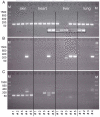Agouti revisited: transcript quantification of the ASIP gene in bovine tissues related to protein expression and localization
- PMID: 22530003
- PMCID: PMC3328439
- DOI: 10.1371/journal.pone.0035282
Agouti revisited: transcript quantification of the ASIP gene in bovine tissues related to protein expression and localization
Abstract
Beside its role in melanogenesis, the agouti signaling protein (ASIP) has been related to obesity. The potentially crucial role in adipocyte development makes it a tempting candidate for economic relevant, fat related traits in farm animals. The objective of our study was to characterize the mRNA expression of different ASIP transcripts and of putative targets in different bovine tissues, as well as to study consequences on protein abundance and localization. ASIP mRNA abundance was determined by RT-qPCR in adipose and further tissues of cattle representing different breeds and crosses. ASIP mRNA was up-regulated more than 9-fold in intramuscular fat of Japanese Black cattle compared to Holstein (p<0.001). Further analyses revealed that a transposon-derived transcript was solely responsible for the increased ASIP mRNA abundance. This transcript was observed in single individuals of different breeds indicating a wide spread occurrence of this insertion at the ASIP locus in cattle. The protein was detected in different adipose tissues, skin, lung and liver, but not in skeletal muscle by Western blot with a bovine-specific ASIP antibody. However, the protein abundance was not related to the observed ASIP mRNA over-expression. Immuno-histochemical analyses revealed a putative nuclear localization of ASIP additionally to the expected cytosolic signal in different cell types. The expression of melanocortin receptors (MCR) 1 to 5 as potential targets for ASIP was analyzed by RT-PCR in subcutaneous fat. Only MC1R and MC4R were detected indicating a similar receptor expression like in human adipose tissue. Our results provide evidence for a widespread expression of ASIP in bovine tissues at mRNA and, for the first time, at protein level. ASIP protein is detectable in adipocytes as well as in further cells of adipose tissue. We generated a basis for a more detailed investigation of ASIP function in peripheral tissues of various mammalian species.
Conflict of interest statement
Figures







Similar articles
-
Agouti Signaling Protein and Its Receptors as Potential Molecular Markers for Intramuscular and Body Fat Deposition in Cattle.Front Physiol. 2018 Mar 6;9:172. doi: 10.3389/fphys.2018.00172. eCollection 2018. Front Physiol. 2018. PMID: 29559925 Free PMC article.
-
Agouti signalling protein (ASIP) gene: molecular cloning, sequence characterisation and tissue distribution in domestic goose.Br Poult Sci. 2016 Jun;57(3):288-94. doi: 10.1080/00071668.2015.1113507. Epub 2016 Apr 20. Br Poult Sci. 2016. PMID: 26750999
-
Characterization of agouti-signaling protein (ASIP) in the bovine ovary and throughout early embryogenesis.Cells Dev. 2024 Sep;179:203930. doi: 10.1016/j.cdev.2024.203930. Epub 2024 May 28. Cells Dev. 2024. PMID: 38815807
-
The early origin of melanocortin receptors, agouti-related peptide, agouti signalling peptide, and melanocortin receptor-accessory proteins, with emphasis on pufferfishes, elephant shark, lampreys, and amphioxus.Eur J Pharmacol. 2011 Jun 11;660(1):61-9. doi: 10.1016/j.ejphar.2010.10.106. Epub 2011 Jan 3. Eur J Pharmacol. 2011. PMID: 21208605 Review.
-
Agouti: from mouse to man, from skin to fat.Pigment Cell Res. 2002 Feb;15(1):10-8. doi: 10.1034/j.1600-0749.2002.00039.x. Pigment Cell Res. 2002. PMID: 11837451 Review.
Cited by
-
Unravelling genetic variation underlying de novo-synthesis of bovine milk fatty acids.Sci Rep. 2018 Feb 1;8(1):2179. doi: 10.1038/s41598-018-20476-0. Sci Rep. 2018. PMID: 29391528 Free PMC article.
-
An interpretive review of selective sweep studies in Bos taurus cattle populations: identification of unique and shared selection signals across breeds.Front Genet. 2015 May 13;6:167. doi: 10.3389/fgene.2015.00167. eCollection 2015. Front Genet. 2015. PMID: 26029239 Free PMC article. Review.
-
Comparative Transcriptome Profile Analysis of Longissimus dorsi Muscle Tissues From Two Goat Breeds With Different Meat Production Performance Using RNA-Seq.Front Genet. 2021 Jan 13;11:619399. doi: 10.3389/fgene.2020.619399. eCollection 2020. Front Genet. 2021. PMID: 33519920 Free PMC article.
-
A genome-wide scan study identifies a single nucleotide substitution in MC1R gene associated with white coat colour in fallow deer (Dama dama).BMC Genet. 2020 Nov 19;21(1):126. doi: 10.1186/s12863-020-00950-3. BMC Genet. 2020. PMID: 33213385 Free PMC article.
-
Intermuscular and intramuscular adipose tissues: Bad vs. good adipose tissues.Adipocyte. 2014 Dec 10;3(4):242-55. doi: 10.4161/adip.28546. eCollection 2014 Oct-Dec. Adipocyte. 2014. PMID: 26317048 Free PMC article.
References
-
- Claycombe KJ, Xue BZ, Mynatt RL, Zemel MB, Moustaid-Moussa N. Regulation of leptin by agouti. Physiol Genomics. 2000;2:101–105. - PubMed
-
- Lu D, Willard D, Patel IR, Kadwell S, Overton L, et al. Agouti protein is an antagonist of the melanocyte-stimulating-hormone receptor. Nature. 1994;371:799–802. - PubMed
-
- Cone RD, Lu D, Koppula S, Vage DI, Klungland H, et al. The melanocortin receptors: agonists, antagonists, and the hormonal control of pigmentation. Recent Prog Horm Res. 1996;51:287–317. - PubMed
MeSH terms
Substances
LinkOut - more resources
Full Text Sources
Molecular Biology Databases

